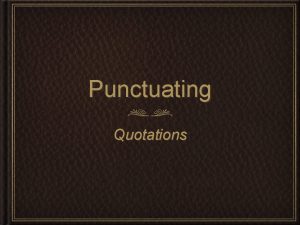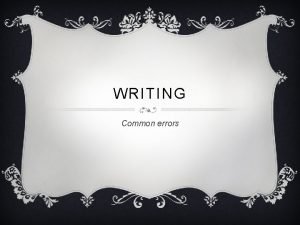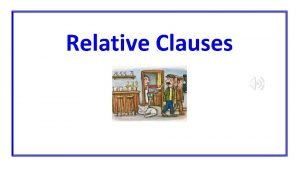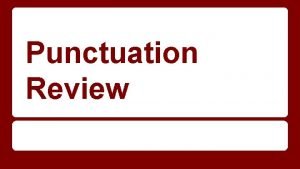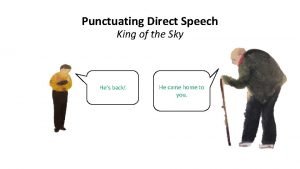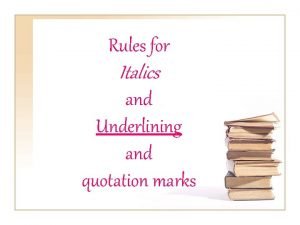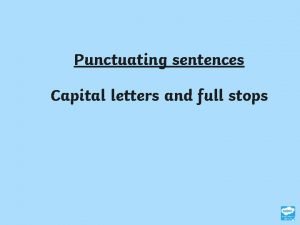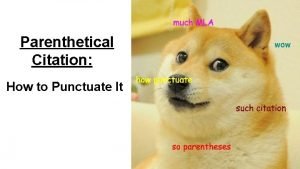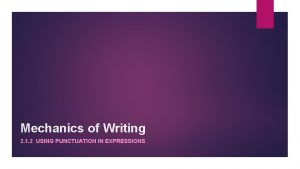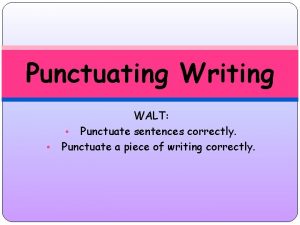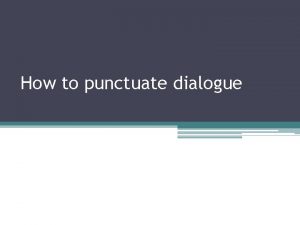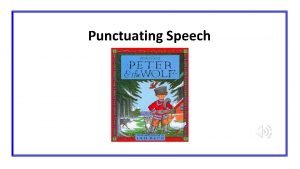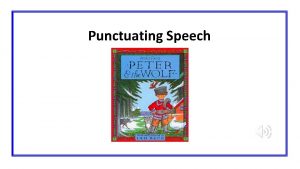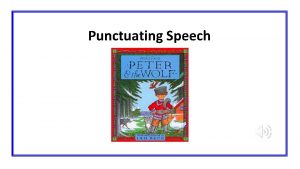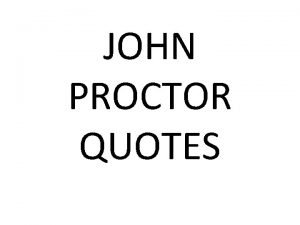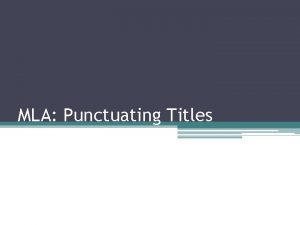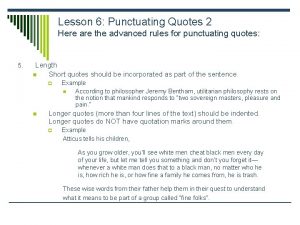How to Punctuate Quotes Punctuating Quotes There are













- Slides: 13

How to Punctuate Quotes

Punctuating Quotes • There are many rules to remember when using quoted materials. • First and foremost, make sure anything using the exact wording of a source is in quote marks “ “ and that anything from a source, exact wording or no, is cited both in-text and in the Works Cited page to avoid plagiarism. • This being said, let’s focus today on how to attach quotes to your sentences.

Attaching Quotes to Your Sentences • There are many ways to attach quotes to your sentences: • Using Commas • Joe-Bob said, “I like cheese. ” • According to the text, “Joe-Bob likes many cheeses. ” • Using a Colon (Only if the first word group is a full sentence, or uses the words “following” or “as follows”) • Joe-Bob likes cheese: “I like many cheeses. ” • On the matter of cheese, Joe-Bob said the following: “I like many cheeses. ” • Use nothing (only if it flows naturally with the sentence) • Joe-Bob “likes many cheeses. ” • On the matter of cheese, Joe-Bob said that he “likes many different types. ”

Avoid Naked Quotes • Never leave a quote completely unattached / by itself / “naked. ” • Example: • DO – Joe-Bob likes cheese: “I am a lover of many cheeses. ” • DO NOT – Joe Bob likes cheese. “I am a lover of many cheeses. ” • Notice how in the first example, the quote is attached to the sentence. This is good. • Notice how in the second example, the quote is all by itself – not attached. Avoid this.

Recapping Quote Punctuation • Yesterday, we learned that quotes should always be attached to sentences, be in quote marks, and require special punctuation when attaching them to your sentences, depending on the circumstances. • Today, we’ll learn about end-quote punctuation.

End-Quote Punctuation • End-Quote punctuation depends on various factors: • Whether or not there’s a citation. • Where the quote ends relative to your sentence. • What punctuation was at the end of your original quote. • Let’s look at quotes without citations first: • When a sentence ends with a quote, it’s easy. Just put your end-punctuation to the left (inside) the end-quote. • Gilbert “went to the store. ” • If your quote is in the middle of the sentence, imagine the quote marks aren’t there and punctuate accordingly ( , go inside , but ; and : go outside). • Gilbert “went to the store” today. • Gilbert said that he “went to the store, ” but I don’t think he did. • I “ran from the monster”; however, it got me, anyway.

End-Quote Punctuation w/ Citations • If you have a citation, the rules change a bit. • If your quote ends with a period, comma, or nothing, leave no punctuation inside the end-quote. Just place a period after the citation: • Bobbi-Jo “went to the dance” (Goober 2). • If your quote ends with a question mark or exclamation point, keep it inside the end-quote, but still put a period after the citation: • Bobbi-Jo “went to the store!” (Goober 2).

Recapping Quote Punctuation • Previously, we learned ways to join quotes to sentences. • We also learned ways to end those sentences. • Today, we will learn about how to amend / alter quoted materials.

Amending Quoted Materials • You are allowed to change or abridge quoted material, so long as you are not altering the spirit of what’s being said (i. e. misrepresenting what’s being said. • One way to amend a quote is the ellipses – three dots. • Original Quote: Joe-Bob and Gilbert really, truly, exceedingly do not like cheese. • DO: I heard that “Joe-Bob and Gilbert really…do not like cheese. ” • DO NOT: I heard that “Joe-Bob and Gilbert really…like cheese. ” • Both examples shorten the quoted material with ellipses, but one accurately represents what was said. The other does not. • Additional rule for ellipses • Use them in the MIDDLE of quoted materials to show words have been omitted. Do NOT use them at the beginning or end of a quote. Fiction writing sometimes does this for pauses / dramatic effect. Essays should NOT do this. • DO: “Joe-Bob…likes cheese. ” • DO NOT: “…Joe-Bob likes cheese. ” or “Joe-Bob likes cheese…”

Amending Quoted Materials • Quotes within Quotes • When there’s dialogue quoted in your quote, all of those quote marks get single quotes instead. • Original from book: Joe-Bob said, “I like cheese. ” • If you quote all of that: “Joe-Bob Said, ‘I like cheese. ’” • Brackets are used to adjust quoted materials to fit the flow of your sentence or bring in omitted words needed for the quote to make sense. Like ellipses, you may use these so long as you do not alter the meaning of the quote: • Original Quote: Books used show many important elements of British literature. • You know it’s talking about books in class, but readers might not. • Your Sentence: The text states that “Books used [in class] show many important elements of British literature.

Recapping Quote Punctuation • Previously, we learned ways to join quotes to sentences. • We also learned ways to end those sentences. • Furthermore, we learned how to amend / alter quoted materials. • Today, we will examine poetry vs. prose and block quotes.

Quoting Poetry vs. Prose • When quoting lines of poetry, use / marks between lines of poetry: • “O me! You juggler! You canker blossom!/ You thief of love! What, have you come by night/ And stol’n my love’s heart from him? ” • Furthermore, when citing poetry, when available, use the line number, chapter and line number if available, or act, scene, and line number, if available (as in plays written in verse): • (Shakespeare 3. 2. 282 -284) for the example above’s quote. This denotes that it is from Act III, Scene II, Lines 282 -284).

Block Quotes • When you have more than three lines of poetry or more than four lines of prose, you must put it into “block” form. • Block quotes can be introduced by comma or colon, depending on whether you start with a complete sentence or not. Consider the following quote: • Notice how I’ve indented twice for each line of quoted material here. Notice how I haven’t used quote marks, either. However, I will cite my quote. One difference – the end punctuation. (Lastnamicus 5) • Avoid using too many block quotes, especially in shorter papers (Yes, 2 -3 page papers are considered short, by college standards. When you get into 10, 15, 20 page papers in college, you can use a few more block quotes, here and there).
 Antigentest åre
Antigentest åre Quotation mark rules for dialogue
Quotation mark rules for dialogue Divided quotation
Divided quotation How to punctuate a book title
How to punctuate a book title Split direct speech
Split direct speech Relative clauses
Relative clauses Punctuating compound sentences
Punctuating compound sentences Punctuating direct speech
Punctuating direct speech Title italics or quotes
Title italics or quotes Give at least three time-keeping or punctuating instruments
Give at least three time-keeping or punctuating instruments Short stories underlined or quotation marks
Short stories underlined or quotation marks Punctuate the sentences
Punctuate the sentences How to punctuate parenthetical citations
How to punctuate parenthetical citations The girls father sat in a corner
The girls father sat in a corner


